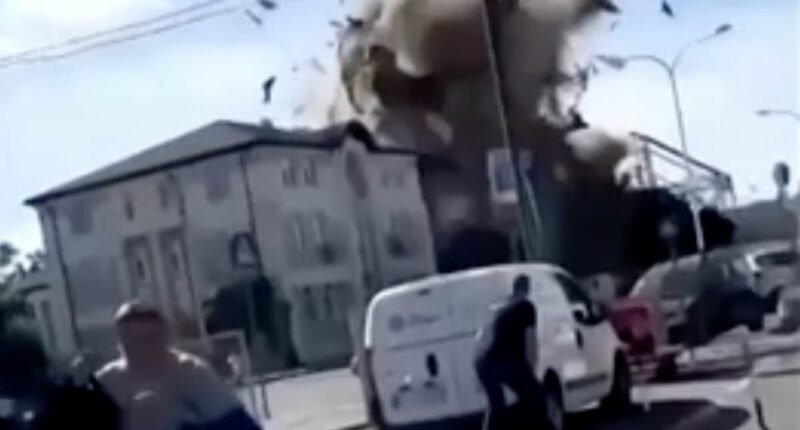Share this @internewscast.com
A Russian drone attack struck the central Ukrainian city of Kharkiv on Tuesday, targeting a university and injuring at least four people.
Terrifying footage shows a kamikaze drone diving into a Kharkiv National Pharmaceutical University building, resulting in a huge explosion.
As the building bursts into flames, passersby are seen running to safety.
The attack took place at around 11am local time, and four people are understood to have been injured, Mayor Ihor Terekhov said.
Governor Oleh Syniehubov condemned the attack, saying: ‘The strike was carried out in broad daylight, near the city center’.
He added that the damaged facility was a purely civilian target with ‘no connection to the military or defense industry.’
The strike on the university follows a Russian forces’ overnight rocket bombardment of the southern Ukrainian city of Zaporizhzhia, injuring 13 people, including two children, as stated by officials on Tuesday.
With the conflict persisting since Russia’s extensive invasion of its neighbor over three years ago, Russian strikes on Ukrainian civilian areas have not ceased, nor has the army’s advance along the approximately 620-mile front line.

A Russian drone attack struck the central Ukrainian city of Kharkiv on Tuesday, targeting a university

Terrifying footage shows a kamikaze drone diving into a Kharkiv National Pharmaceutical University building, resulting in a huge explosion

institution in the Slobidskyi district after Russian attack in Kharkiv, Ukraine on September 16, 2025
A peace settlement appears to be no closer despite months of U.S.-led peace efforts.
President Donald Trump’s ultimatums and deadlines for Putin to engage with proposals to stop the fighting have passed without obvious consequences.
In just the previous two weeks, Zelensky reported on Telegram that Russia has targeted Ukraine with over 3,500 drones, more than 2,500 formidable glide bombs, and nearly 200 missiles.
Russian glide bombs, typically released by jets at high altitudes and well behind the front lines, along with drone swarms, pose significant challenges for Ukrainian defenses.
Glide bombs aren’t very accurate, but they leave big craters, and Ukraine has no effective countermeasure against them.
Russian drones also recently landed on Polish soil, prompting NATO to beef up the alliance’s European air defenses as tensions with Moscow mounted.
‘Now is the time to establish joint protection for our European skies through a multilayered air defense system. All the necessary technologies are available,’ Zelensky stated on Telegram. ‘We need investments and determination, robust actions, and decisions from all our partners.’
In Zaporizhzhia, the Russian barrage struck more than 20 apartment buildings, starting fires, regional head Ivan Fedorov said on national television.

Passersby can are seen running to safety following the attack

Firefighter teams perform extinguishing tasks at an educational institution in the Slobidskyi district following a Russian UAV attack in Kharkiv, Ukraine on September 16, 2025.

Governor Oleh Syniehubov condemned the attack
‘We hadn’t yet recovered from enemy strikes on Aug. 30. We are currently repairing those buildings, those windows, but now the enemy has added more work for our municipal workers,’ Fedorov said.
In response, Ukraine has developed its own long-range drones that have hit deep inside Russia, damaging installations vital for Russia’s war effort.
Recent strikes have included oil refineries, depots and terminals.
Russia remains the world’s second-largest oil exporter, but a seasonal rise in demand and sustained Ukrainian drone strikes have caused gasoline shortages in recent weeks.
Ukraine’s General Staff said Tuesday that the armed forces struck an oil refinery in the Saratov region of western Russia during the night.
Explosions and a fire were reported at the facility, the General Staff said on its Facebook page.

















